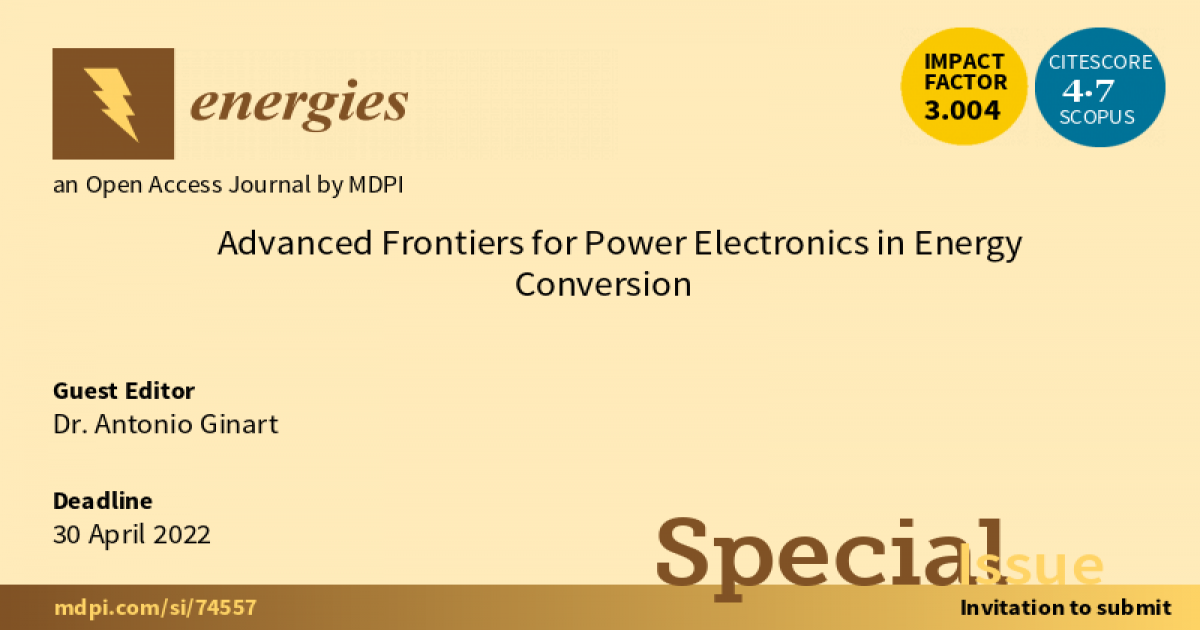Advanced Frontiers for Power Electronics in Energy Conversion
A special issue of Energies (ISSN 1996-1073). This special issue belongs to the section "F: Electrical Engineering".
Deadline for manuscript submissions: closed (30 April 2022) | Viewed by 5556

Special Issue Editor
Special Issue Information
Dear Colleagues,
World growing population creates the need of paramount efficient and sustainable, handling of energy. Power electronics has enabled efficient use of energy, and its techniques continue to expand its already large field of influence. Examples of its penetration are already present in ubiquitous equipment such as laptops and cell phones, rendering continuous improvement in rapid and lasting charges, also in new repeaters technologies like 5G, in finance with bitcoin mining, data centers in general, gaming industry, and space exploration. It is clear the impact on transportation with the continuous growth of electric vehicles (EVs). The last decade has seen an accelerated and remarkable insertion of power electronics into traditional power systems with solar and wind generation, storage, transmission, and distribution. This Special Issue is about the inroad that power electronics plays challenging traditional energy approaches that still prevail in some fashion and pushing to new horizons. Topics of interest for publication include but are not limited to:
- Ultra-efficient converter for microelectronics.
- Advanced application in power systems, including generation, transmission, and distribution.
- Residential power applications including lighting, high-efficient air conditioning, and water heaters
- Solid-state transformers
- Energy storage, including new batteries, controls, and PHM (Prognostic Health Management) techniques.
- Converter for telecom especially for 5G applications
- Power wireless transmission
- Power electronics in transportation including charging station
- Special power converter for emerging fields
Dr. Antonio Ginart
Guest Editor
Manuscript Submission Information
Manuscripts should be submitted online at www.mdpi.com by registering and logging in to this website. Once you are registered, click here to go to the submission form. Manuscripts can be submitted until the deadline. All submissions that pass pre-check are peer-reviewed. Accepted papers will be published continuously in the journal (as soon as accepted) and will be listed together on the special issue website. Research articles, review articles as well as short communications are invited. For planned papers, a title and short abstract (about 100 words) can be sent to the Editorial Office for announcement on this website.
Submitted manuscripts should not have been published previously, nor be under consideration for publication elsewhere (except conference proceedings papers). All manuscripts are thoroughly refereed through a single-blind peer-review process. A guide for authors and other relevant information for submission of manuscripts is available on the Instructions for Authors page. Energies is an international peer-reviewed open access semimonthly journal published by MDPI.
Please visit the Instructions for Authors page before submitting a manuscript. The Article Processing Charge (APC) for publication in this open access journal is 2600 CHF (Swiss Francs). Submitted papers should be well formatted and use good English. Authors may use MDPI's English editing service prior to publication or during author revisions.
Keywords
- EV
- Power electronic in distribution
- Power electronic in transmission
- Energy storage
- Smart homes
- Microgrid
- Energy





